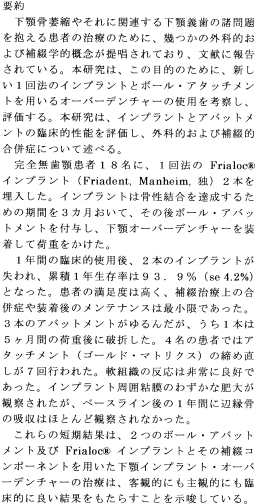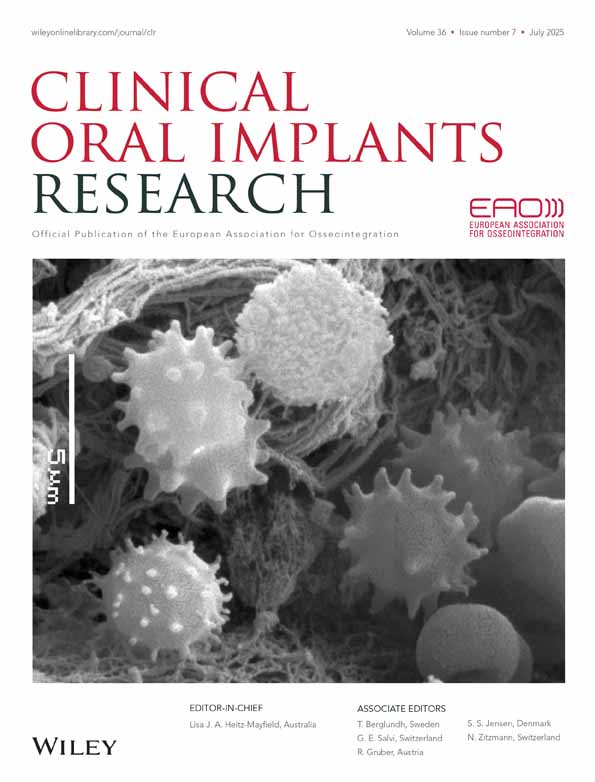A prospective evaluation of Frialoc® implants with ball-abutments in the edentulous mandible: 1-year results
Eine prospektive Auswertung von Frialoc® Implantaten mit Kugelankern im zahnlosen Unterkiefer: 1-Jahres-Resultate
Abstract
enAbstract: Several surgical and prosthetic concepts for the treatment of patients with mandibular atrophy and related lower denture problems are proposed and described in the literature. The present study discusses and evaluates the use of a new single-stage implant and overdenture with ball-attachment for this purpose. This study evaluates the clinical performance of the implants and abutments and addresses surgical and prosthetic complications that were encountered. Eighteen fully edentulous patients received two, single-stage Frialoc® implants (Friadent, Mannheim, Germany). The implants were left to osseointegrate for 3 months and were subsequently provided with ball-abutments and loaded through a mandibular overdenture. After 1-year of clinical service, two implants were lost, which accumulated to a 1-year survival rate of 93.9% (SE 4.2%). Patient satisfaction was high, and prosthetic complications and postinsertion maintenance were minimal. Three abutments loosened, one of which subsequently broke after 5 months of loading. Retightening of the attachment (gold matrix) was performed on seven occasions in four patients. Soft tissue response was excellent. Although minor hypertrophy of the peri-implant mucosa was observed, hardly any marginal bone loss between baseline and 1-year observations occurred. Short-term results indicate that mandibular implant overdenture treatment by means of two ball-abutments, using Frialoc® implants and prosthetic components, leads to good clinical results, both from an objective and a subjective perspective.
Résumé
frDifférents concepts tant chirurgicaux que prothétiques pour le traitement de patients avec une mandibule atrophiée et des problèmes de la prothèse inférieure sont proposés et décrits dans la littérature. L'étude présente discute et évalue l'utilisation d'un nouvel implant placé en une étape et d'une prothèse avec attache-boule. Cette étude évalue la performance clinique des implants et des piliers, et rapporte les complications chirurgicales et prothétiques rencontrées. Dix-huit patients édentés ont reçu deux implants Frialoc® placés en une étape (Friandent, Mannheim, Allemagne). Ces implants sont restés in situ pour l'ostéoïntégration pendant trois mois, ont ensuite reçu des piliers-boule puis ont été mis en charge par une prothèse amovible mandibulaire. Une année après la mise en service, deux implants étaient perdus, d'où un taux de survie à un an de 94%. La satisfaction des patients était importante, les complications prothétiques et le maintien après l'insertion étaient minimes. Trois piliers ont été perdus, dont un cassé après cinq mois sa mise en charge. Le resserage de l'attache (matrice or) a été effectué en sept occasions chez quatre patients. La réponse tissulaire des tissus mous était excellente. Bien qu'une hypertrophie mineure de la muqueuse paroïmplantaire était observée, il n'y avait presque pas de perte osseuse marginale entre les examens initiaux et après un an. Ces résultats à court terme indiquent que la prothèse amovible inférieure sur implants avec deux piliers boules sur implant Frialoc® donnent de bons résultats cliniques tant d'une perspective objective que subjective.
Zusammenfassung
deIn der Literatur werden verschiedene chirurgische und prothetische Konzepte für die Versorgung von Patienten mit atrophierten Unterkiefern und entsprechenden Prothesenproblemen vorgeschlagen und beschrieben. Die vorliegende Studie diskutiert und evaluiert die Anwendung eines neuen einphasigen Implantats und Hybridprothesen auf Kugelankern zur Behandlung dieser Situation. Die Studie untersucht die klinische Brauchbarkeit der Implantate und Prothetikteile und bespricht chirurgische und prothetische Komplikationen, welche angetroffen wurden. Achtzehn zahnlose Patienten erhielten 2 einphasige Frialoc® Implantate (Friadent, Mannheim, Deutschland). Die Implantate blieben 3 Monate unbelastet zur Osseointegration. Danach wurden sie mit Kugelankern versehen und mit einer Unterkieferhybridprothese belastet.
Nach 1 Jahr in Funktion waren 2 Implantate verloren gegangen, was einer 1-Jahres-Ueberlebensrate von 93.9% (SE 4.2%) entsprach. Die Zufriedenheit der Patienten war gross. Die prothetischen Komplikationen und die Unterhaltsarbeiten nach dem Einsetzen waren minimal. Drei Prothetikteile lockerten sich und eines davon brach nach einer Belastungszeit von 5 Monaten. Eine Re-Aktivierung der Goldmatrizen musste in 7 Fällen bei 4 Patienten durchgeführt werden. Die Antwort der Weichgewebe war ausgezeichnet. Obwohl eine minimale Hypertrophie der peri-implantären Mukosa beobachtet werden konnte, trat fast kein marginaler Knochenverlust zwischen der Ausgangs- und der 1 Jahresuntersuchung auf.
Die Kurzzeitresultate zeigen, dass eine Behandlung mit implantatgetragenen Hybridprothesen im Unterkiefer, welche mit 2 Kugelankern auf Frialoc® Implantaten und Prothetikteilen befestigt sind, sowohl zu subjektiv als auch zu objektiv guten klinischen Resultaten führt.
Resumen
esSe han propuesto y descrito en la literatura varios conceptos quirúrgicos y prostéticos para el tratamiento de pacientes con atrofia mandibular y problemas relacionados con la dentadura inferior. El presente estudio discute y evalúa el uso de un nuevo tipo de implante de una sola fase y sobredentadura con tache de bola para esta propósito. Este estudio evalúa el rendimiento clínico de los implantes y de los pilares y señala las complicaciones quirúrgicas y prostéticas encontradas.
Dieciocho pacientes totalmente edéntulos recibieron 2 implantes Frialoc® de una sola fase (Friadent, Mannheim, Alemania). Los implantes se dejaron integrar durante 3 meses y subsecuentemente se les suministraron pilares de bola y se cargaron con una sobredentadura mandibular.
Tras 1 año de servicio clínico, se perdieron 2 implantes, que acumularon un índice de supervivencia de 1 año del 93.9% (se 4.2%). La satisfacción de los pacientes fue alta, y las complicaciones protésicas y el mantenimiento post inserción fueron mínimos. Tres pilares se aflojaron, uno de ellos se rompió posteriormente tras 5 meses de carga. El reapretado del atache (gold matriz) se llevó a cabo en 7 ocasiones en 4 pacientes. La respuesta del tejido blando fue excelente. Aunque se observó una ligera hipertrofia de la mucosa periimplantaria, difícilmente ocurrió alguna pérdida ósea marginal entre el momento inicial y las observaciones d 1 año.
Los resultados a corto plazo indican que el tratamiento de sobredentadura de implantes mandibulares por medio de 2 pilares de bola, usando implantes Frialoc® y componentes prostéticos, conducen a unos buenos resultados clínicos, tanto desde un punto de vista objetivo como desde una perspectiva subjetiva.





